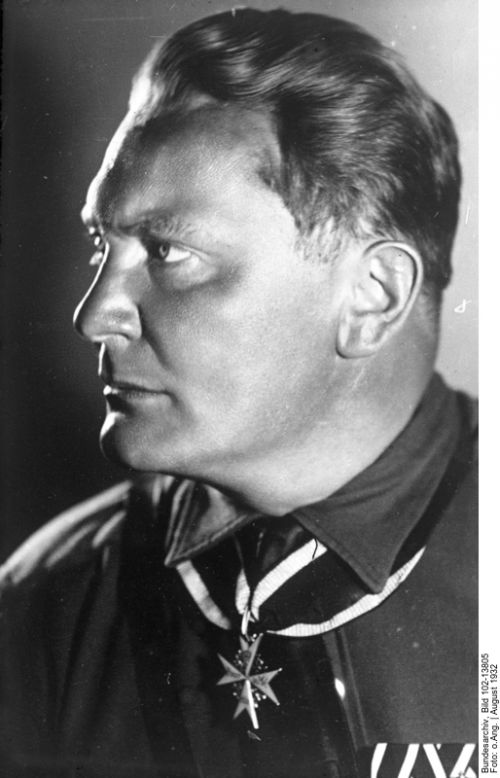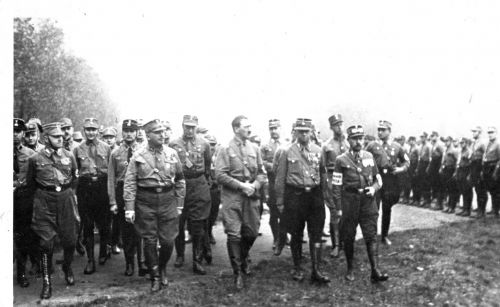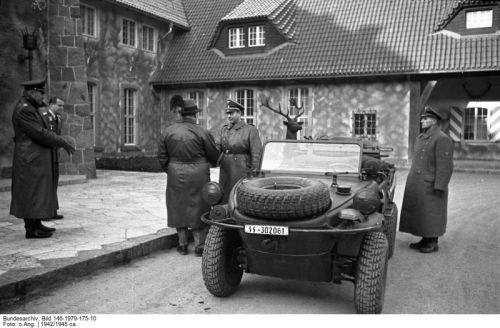Hermann Goering

Hermann Goering - August 1932 (Bundesarchiv)
Hermann Goering was born in Rosenheim on January 12, 1893. The son of a judge, who had been sent by Bismarck to South-West Africa as the first Resident Minister Plenipotentiary. Hermann Goering entered the army in 1914, as an Infantry Lieutenant, before being transferred to the air force as a combat pilot. He was the last Commander in 1918, of the Richthofen Fighter Squadron. Goering distinguished himself as an air ace, credited with shooting down twenty-two Allied aircraft. He was awarded the Pour le Merite and the Iron Cross -First Class, he ended the war with the romantic aura of a much decorated pilot and war hero.
After the First World War he was employed as a show-flier and a pilot in Denmark and Sweden, where he met his first wife, Baroness Karin von Fock-Kantzow, whom he married in Munich on February 3, 1922. Goering's aristocratic background and his prestige as a war hero made him a prize recruit to the infant Nazi Party and Adolf Hitler appointed him to command the SA Brownshirts in December 1922. Nazism offered the swashbuckling Goering the promise of action, adventure, comradeship and a channel for his hunger for power.
On November 8 -9, 1923, he took part in the Munich Beer -Hall putsch, in which he was seriously wounded and forced to flee from Germany for four years until a general amnesty was declared. He escaped to Austria, Italy, and then Sweden. He was admitted to a mental hospital and, in September 1925, to an asylum for dangerous patients, becoming a morphine addict in the course of his extended recovery.
Hermann Goering returned to Germany during 1927, where he re-joined the Nazi Party and was elected as one of the first deputies to the Reichstag a year later. During the next five years Goering played a major part in smoothing Hitler's road to power, using his contacts with conservative circles, big business and army officers to reconcile them to the Nazi Party and orchestrating the electoral triumph of July 31, 1932, which brought him the Presidency of the Reichstag. Following Hitler's appointment as Chancellor on January 30, 1933, Goering was made Prussian Minister of the Interior, Commander -in -Chief of the Prussian Police and Gestapo, and Commissioner for Aviation.
As the creator of the secret police, Goering together with Heinrich Himmler and Reinhard Heydrich, established the early concentration camps for political opponents, showing formidable energy in terrorising and crushing all resistance. Under the pretext of a threatened communist coup, Prussia was 'cleansed' and hundreds of officers and thousands of ordinary policemen were purged, being replaced from the great reservoir of SA and SS men, who took over the policing of Berlin.
Goering exploited the Reichstag fire which took place on February 27, 1933, and was blamed on the Communists, and he implemented a series of emergency decrees that destroyed the last remnants of civil liberties in Germany, to imprison communists and Social Democrats, banned the left-wing press. Goering directed operations, just over a year later during the Blood Purge, that was known as 'the Night of the Long Knives, which eliminated his rival Ernst Rohm, the leader of the SA, other SA Leaders and other political opponents of the Nazis, on June 30, 1934.

Ernst Rohm next to Adolf Hitler flanked by SA Men (Chris Webb Private Archive)
On March 1, 1935, Goering was appointed Commander-in-Chief of the Air Force and, with Ernst Udet and Erhard Milch were responsible for organising the rapid build-up of the aircraft industry and training of pilots. In 1936, his powers were further extended by his appointment as Plenipotentiary for the implementation of the Four Year Plan, which gave Goering virtually dictatorial controls to direct the German economy. The creation of the state-owned Hermann Goering Works in 1937, a gigantic industrial nexus which employed 700,000 workers and amassed a capital of 400 million marks, enabled him to accumulate a vast fortune.
Goering used his position to indulge in ostentatious luxury, living in a palace in Berlin and building a hunting mansion named after his first wife Karin, called Carinhall, north-east of Berlin, in the Schorfheide Forest. Karin died of tuberculosis during 1931. At Carinhall he organised feasts, state hunts, showed off his stolen art treasures. Changing uniforms and suits five times a day, affecting an archaic Germanic style of hunting dress, flouting his medals and jewellery . Goering's transparent enjoyment of the trappings of power, his bribe-taking gradually corrupted his judgement

Goering welcomes an SS Officer at Carinhall (Bundesarchiv)
Despite all his excesses Goering remained genuinely popular with the German masses who regarded him as manly, honest and more accessible than Adolf Hitler, and other leading figures in Hitler's circle, mistaking his extrovert bluster and vitality for human warmth. Goering's cunning, brutality, and ambition were displayed in the cabal he engineered against the two leading army generals, Werner von Fritsch and Werner von Blomberg, whom he helped to bring down in February 1938, in the misplaced hope that he would step into their shoes.
Following the Kristallnacht pogrom which took place on November 9, 1938, it was Goering who came up with the proposal for fining the Jewish Communities a billion Marks and ordered the Jews to be eliminated from the German economy, the 'Aryanisation' of their property and businesses, and their exclusion from schools, resorts, parks, forests etc. On November 12, 1938, Goering warned of a 'final reckoning with the Jews' should Germany come into conflict with a foreign power.
It was also Goering who instructed Reinhard Heydrich on July 31, 1941, to carry out all preparations with regard to a general solution of the Jewish question in those territories of Europe which are under German influence. Goering identified with Hitler's territorial aspirations, playing a key role in bringing about the Anschluss with Austria in March 1938 and the subsequent occupation of Czechoslovaka. Goering sought the establishment of a German New Order, through diplomacy rather than naked aggression.
Goering was appointed Reich Council Chairman for National Defence on August 30, 1939, and was officially designated as Hitler's successor on September 1, 1939. Goering directed the all-conquering Luftwaffe campaigns against Poland, France and the Low Countries and on June 19, 1940, he was promoted to Reichsmarchall.
In August 1940, he confidently threw himself into the great offensive against Great Britain, Operation Eagle was conceived to drive the RAF from the skies and secure the surrender of the British by means of the Luftwaffe alone. Goering however, lost control of the Battle of Britain and made a fatal, tactical error when he switched to massive night bombings of London on September 7, 1940, just when the British fighter defences were reeling from losses in the air and on the ground. This moved saved the RAF sector control stations from destruction and gave the British fighter defences precious time to recover. The failure of the Luftwaffe, which Hitler never forgave, caused the abandonment of Operation Sea Lion, the planned invasion of the British Isles, and began the political eclipse of Goering.
Further failures of the Luftwaffe on the Russian front, particularly the failure to supply the beleaguered Sixth Army in Stalingrad and its inability to defend Germany itself from Allied bombing attacks. Goering had made a speech in September 1939, where he said,' No enemy bomber can reach the Ruhr. If one reaches the Ruhr, my name is not Goering. You can call me Meyer.' The Germans mocked Goering for this when the Allied forces started to destroy Germany from air attacks day and night, they started calling air raid sirens, 'Meyer's trumpets.'
Following the defeat at Stalingrad Goering rapidly sank into lethargy and despondency. He expressly forbade General Adolf Galland to report that enemy fighters were accompanying bomber squadrons deeper and deeper into German territory during 1943. Goering had become a bloated shadow of his former self, discredited, isolated and increasingly despised by Hitler, who blamed Goering for Germany's defeats. Undermined by Martin Borman's intrigues, overtaken in influence by Himmler, Goebbels and Speer, mentally humiliated by his servile dependence on Hilter, Goering's personality began to disintegrate.
When Hitler declared in 1945, that he would remain in his Berlin bunker to the end, Goering, who had already left for Bavaria, misinterpreted this as an abdication and requested that he be allowed to take over at once; he was ignominiously dismissed from all his posts, expelled from the Nazi Party and arrested. Shortly afterwards on May 9, 1945, Goering was captured by troops of the American Seventh Army and, to his great surprise, put on trial at Nuremberg during 1946.
During his trial Goering, who had lost a lot of weight in captivity, and had been taken off drugs, defended himself with aggressive vigour and skill, frequently outwitting the prosecuting counsel. With Hitler dead, he stood out among the defendants as the dominating personality, dictating attitudes to other prisoners in the dock and adopting a pose of self-conscious heroism motivated by the belief that he would be immortalised as a German martyr. Nevertheless, Goering failed to convince the judges, who found him guilty on all four counts: of conspiracy to wage war, crimes against peace, war crimes and crimes against humanity. No mitigating circumstances were found and Goering was sentenced to death by hanging.
On October 15, 1946, two hours before his execution was due to take place, Goering committed suicide in his Nuremburg cell, taking a capsule of poison that he had concealed from his guards during his captivity.
Sources
Who’s Who in Nazi Germany by Robert S Wistrich, published by Routledge, London 1995
Leaders and Personalities of the Third Reich by Charles Hamilton, published by R.James Bender Publishing. San Jose, USA 1984.
Photographs – Bundesarch, Chris Webb Private Archive
© Holocaust Historical Society 2018

